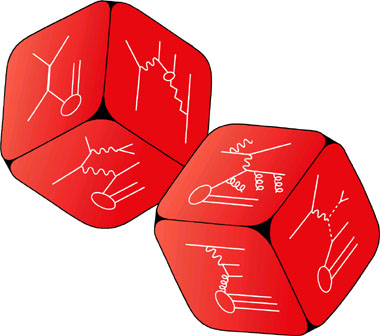Monte-Carlo methods are vital simulation tools for studying high-energy particle collisions. To push the development of the Monte-Carlo generators, their underlying models and technical solutions, DESY is running a “Monte Carlo Generators for HERA Physics” workshop.
Monte-Carlo programs for computer simulation of complex interactions in high-energy particle collisions are indispensable tools for today’s experiments. Their usefulness includes the extraction of physics and testing theories and models, as well as planning future experiments and analyses. Although the development of such Monte-Carlo simulations are based on theoretical models, it is to a large extent pushed by experimental results.
The H1 and ZEUS experiments at the unique electronproton collider HERA at the German DESY laboratory in Hamburg are now in full swing. They produce data of high quality and increasing precision, which will be further boosted after the forthcoming luminosity upgrade of HERA. This subjects the Monte-Carlos to stringent tests and can reveal important gaps in our understanding, for example when data demonstrate that the Monte-Carlos are deficient.
To push the development of the Monte-Carlo generators, their underlying models and technical solutions, DESY is running a “Monte Carlo Generators for HERA Physics” workshop until early 1999. It was launched with a start up meeting in April with the participation of about 100 experimentalists and theorists.
Welcome
They were welcomed by the DESY research director Albrecht Wagner, who outlined progress on the HERA upgrade in 2000/2001 and noted that there would be yet more data to understand. He encouraged theorists and experimentalists to get together in a coordinated effort to improve their models and develop new ones. To set the scene for the following discussions, H1 and ZEUS experimentalists presented their latest results with the spotlight on problem areas for Monte-Carlos.
Much time was then devoted to various aspects of quantum chromodynamics (QCD), the quantum field theory for the strong interactions of quarks and gluons. The focus was on the connection between the latest theoretical developments and their Monte-Carlo implementation, since it is not easy to transform the theoretical formalism into computer simulation code.
Many different processes are of interest here, such as how to simulate properly the emission of many gluons in a so-called QCD cascade and the resulting final state of observable hadrons. Also of great interest are the attempts to understand the dynamics giving rise to the kinematically biassed “rapidity gap” events discovered at HERA a few years ago.
Virtual photon

Another challenge is to understand the transition from photoproduction to deep-inelastic scattering, when the exchanged photon changes from real to virtual. To measure and explain the “resolved” structure of the photon in terms of a quark and gluon content has become a minor industry, and recent HERA data indicate that this structure is important also at higher photon virtuality. Not only does the exchanged photon probe the structure of the proton in HERA, but the partons in the proton also probe the structure of the photon! Monte-Carlo models for exotic processes beyond the Standard Model will become increasingly important as HERA luminosity increases. The search for new physics requires improved precision in the Standard Model calculations of, for example, radiative corrections.
The workshop is not confined to HERA physics, but also considers related problems in other interactions, for example at CERN’s LEP electronpositron collider or Fermilab’s Tevatron. The meeting addressed these topics in 16 plenary and 28 parallel talks. Among them were talks by T Abe, S Baranov, C Berger, R Engel, D Graudenz, G Ingelman, H Jung, Y Kurihara, L Lönnblad, B Pötter, J Rathsman, G Salam, M Seymour, T Sjöstrand, A Solano, H Spiesberger, and L West authors of many of the Monte-Carlo programs used at HERA and elsewhere.
Several working groups were formed to study these issues in depth. These groups meet regularly and the whole workshop had a mid-term meeting in October. The final results will be reported in a meeting at DESY from 15 February 1999.
Further reading
Anybody interested is welcome to join. More information is available at the workshop homepage “http://www.desy.de/~heramc/”.








